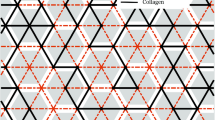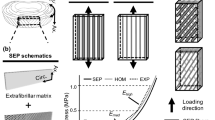Abstract
While collagen is recognized as the predominant mechanical component of soft connective tissues, the role of the non-fibrillar matrix (NFM) is less well understood. Even model systems, such as the collagen-agarose co-gel, can exhibit complex behavior, making it difficult to identify relative contributions of specific tissue constituents. In the present study, we developed a two-component microscale model of collagen-agarose tissue analogs and used it to elucidate the interaction between collagen and NFM in uniaxial tension. Collagen fibers were represented with Voronoi networks, and the NFM was modeled as a neo-Hookean solid. Model predictions of total normal stress and Poisson’s ratio matched experimental observations well (including high Poisson’s values of ~3), and the addition of NFM led to composition-dependent decreases in volume change and increases in fiber stretch. Because the NFM was more resistant to volume change than the fiber network, extension of the composite led to pressurization of the NFM. Within a specific range of parameter values (low shear modulus and moderate Poisson’s ratio), the magnitude of the reaction force decreased relative to this pressurization component resulting in a negative (compressive) NFM stress in the loading direction, even though the composite tissue was in tension.








Similar content being viewed by others
References
Adeeb, S., et al. Modelling the behaviour of ligaments: a technical note. Comput. Methods Biomech. Biomed. Eng. 7(1):33–42, 2004.
Amoroso, N. J., et al. Elastomeric electrospun polyurethane scaffolds: the interrelationship between fabrication conditions, fiber topology, and mechanical properties. Adv. Mater. 23(1):106–111, 2011.
Arruda, E. M., and M. C. Boyce. A three-dimensional constitutive model for the large stretch behavior of rubber elastic materials. J. Mech. Phys. Solids 41(2):389–412, 1993.
Ault, H. K., and A. H. Hoffman. A composite micromechanical model for connective tissues: part I—theory. J. Biomech. Eng. 114(1):137–141, 1992.
Ault, H. K., and A. H. Hoffman. A composite micromechanical model for connective tissues: part II—application to rat tail tendon and joint capsule. J. Biomech. Eng. 114(1):142–146, 1992.
Barber, C. B., D. P. Dobkin, and H. T. Huhdanpaa. The quickhill algorithm for convex hulls. ACM Trans. Math. Softw. 22(4):469–483, 1996.
Benkherourou, M., et al. Standardization of a method for characterizing low-concentration biogels: elastic properties of low-concentration agarose gels. J. Biomech. Eng. 121(2):184–187, 1999.
Billiar, K. L., and M. S. Sacks. A method to quantify the fiber kinematics of planar tissues under biaxial stretch. J. Biomech. 30(7):753–756, 1997.
Billiar, K. L., and M. S. Sacks. Biaxial mechanical properties of the native and glutaraldehyde-treated aortic valve cusp: part II—a structural constitutive model. J. Biomech. Eng. 122(4):327–335, 2000.
Bischoff, J. E., E. M. Arruda, and K. Grosh. A microstructurally based orthotropic hyperelastic constitutive law. J. Appl. Mech. 69:570–579, 2002.
Chandran, P. L., and V. H. Barocas. Deterministic material-based averaging theory model of collagen gel micromechanics. J. Biomech. Eng. 129(2):137–147, 2007.
Cortes, D. H., and D. M. Elliott, Extra-fibrillar matrix mechanics of annulus fibrosus in tension and compression. Biomech. Model. Mechanobiol., 2011. doi:10.1007/s10237-011-0351-x.
D’Amore, A., et al. Characterization of the complete fiber network topology of planar fibrous tissues and scaffolds. Biomaterials 31(20):5345–5354, 2010.
Driessen, N. J., C. V. Bouten, and F. P. Baaijens. A structural constitutive model for collagenous cardiovascular tissues incorporating the angular fiber distribution. J. Biomech. Eng. 127(3):494–503, 2005.
Driessen, N. J., et al. Computational analyses of mechanically induced collagen fiber remodeling in the aortic heart valve. J. Biomech. Eng. 125(4):549–557, 2003.
Driessen, N. J., et al. A computational model for collagen fibre remodelling in the arterial wall. J. Theor. Biol. 226(1):53–64, 2004.
Driessen, N. J., et al. Modeling the mechanics of tissue-engineered human heart valve leaflets. J. Biomech. 40(2):325–334, 2007.
Driessen, N. J., et al. Remodelling of the angular collagen fiber distribution in cardiovascular tissues. Biomech. Model. Mechanobiol. 7(2):93–103, 2008.
Gasser, T. C., R. W. Ogden, and G. A. Holzapfel. Hyperelastic modelling of arterial layers with distributed collagen fibre orientations. J. R. Soc. Interface 3(6):15–35, 2006.
Gilbert, T. W., et al. Fiber kinematics of small intestinal submucosa under biaxial and uniaxial stretch. J. Biomech. Eng. 128(6):890–898, 2006.
Guerin, H. A., and D. M. Elliott. Degeneration affects the fiber reorientation of human annulus fibrosus under tensile load. J. Biomech. 39(8):1410–1418, 2006.
Guerin, H. L., and D. M. Elliott. Quantifying the contributions of structure to annulus fibrosus mechanical function using a nonlinear, anisotropic, hyperelastic model. J. Orthop. Res. 25(4):508–516, 2007.
Hepworth, D. G., et al. Affine versus non-affine deformation in soft biological tissues, measured by the reorientation and stretching of collagen fibres through the thickness of compressed porcine skin. J. Biomech. 34(3):341–346, 2001.
Hewitt, J., et al. Regional material properties of the human hip joint capsule ligaments. J. Orthop. Res. 19(3):359–364, 2001.
Holzapfel, G. A. Nonlinear Solid Mechanics: A Contiuum Approach for Engineering. Chichester: John Wiley and Sons, 2000.
Holzapfel, G. A., T. C. Gasser, and R. W. Ogden. A new constitutive framework for arterial wall mechanics and a comparative study of material models. J. Elast. 61:1–48, 2000.
Horowitz, A., I. Sheinman, and Y. Lanir. Nonlinear incompressible finite element for simulating loading of cardiac tissue—part II: three dimensional formulation for thick ventricular wall segments. J. Biomech. Eng. 110(1):62–68, 1988.
Horowitz, A., et al. Structural three-dimensional constitutive law for the passive myocardium. J. Biomech. Eng. 110(3):200–207, 1988.
Horowitz, A., et al. Nonlinear incompressible finite element for simulating loading of cardiac tissue—part I: two dimensional formulation for thin myocardial strips. J. Biomech. Eng. 110(1):57–61, 1988.
Julkunen, P., et al. Comparison of single-phase isotropic elastic and fibril-reinforced poroelastic models for indentation of rabbit articular cartilage. J. Biomech. 42(5):652–656, 2009.
Kabla, A., and L. Mahadevan. Nonlinear mechanics of soft fibrous networks. J. R. Soc. Interface 4(12):99–106, 2007.
Kang, J., et al. Response of an actin filament network model under cyclic stretching through a coarse grained Monte Carlo approach. J. Theor. Biol. 274(1):109–119, 2011.
Kiviranta, P., et al. Collagen network primarily controls Poisson’s ratio of bovine articular cartilage in compression. J. Orthop. Res. 24(4):690–699, 2006.
Kuhl, E., et al. Remodeling of biological tissue: mechanically induced reorientation of a transversely isotropic chain network. J. Mech. Phys. Solids 53:1552–1573, 2005.
Lake, S. P. Anisotropic, inhomogeneous and non-linear structure-function of human supraspinatus tendon. Ph.D. Thesis. University of Pennsylvania, Philadelphia, PA, 2009.
Lake, S. P., and V. H. Barocas. Mechanical and structural contribution of non-fibrillar matrix in uniaxial tension: a collagen-agarose co-gel model. Ann. Biomed. Eng. 39(7):1891–1903, 2011.
Lake, S. P., E. S. Hald, and V. H. Barocas. Collagen-agarose co-gels as a model for collagen-matrix interaction in soft tissues subjected to indentation. J. Biomed. Mater. Res. A 99(4):507–515, 2011.
Lake, S. P., et al. Effect of fiber distribution and realignment on the nonlinear and inhomogeneous mechanical properties of human supraspinatus tendon under longitudinal tensile loading. J. Orthop. Res. 27(12):1596, 2009.
Lake, S. P., et al. Evaluation of affine fiber kinematics in human supraspinatus tendon using quantitative projection plot analysis. Biomech. Model. Mechanobiol. 11(1–2):197–205, 2012.
Lanir, Y. A structural theory for the homogeneous biaxial stress-strain relationships in flat collagenous tissues. J. Biomech. 12(6):423–436, 1979.
Lynch, H. A., et al. Effect of fiber orientation and strain rate on the nonlinear uniaxial tensile material properties of tendon. J. Biomech. Eng. 125(5):726–731, 2003.
Maceri, F., M. Marino, and G. Vairo. A unified multiscale mechanical model for soft collagenous tissues with regular fiber arrangement. J. Biomech. 43(2):355–363, 2010.
Martufi, G., and T. C. Gasser. A constitutive model for vascular tissue that integrates fibril, fiber and continuum levels with application to the isotropic and passive properties of the infrarenal aorta. J. Biomech. 44(14):2544–2550, 2011.
Nachtrab, S., et al. Morphology and linear-elastic moduli of random network solids. Adv. Mater. 23(22–23):2633–2637, 2011.
Nagel, T., and D. J. Kelly. The influence of fiber orientation on the equilibrium properties of neutral and charged biphasic tissues. J. Biomech. Eng. 132(11):114506, 2010.
Nagel, T., and D. J. Kelly. Remodelling of collagen fibre transition stretch and angular distribution in soft biological tissues and cell-seeded hydrogels. Biomech. Model. Mechanobiol. 11(3–4):325–339, 2012.
O’Connell, G. D., H. L. Guerin, and D. M. Elliott. Theoretical and uniaxial experimental evaluation of human annulus fibrosus degeneration. J. Biomech. Eng. 131(11):111007, 2009.
Peng, X. Q., Z. Y. Guo, and B. Moran. An anisotropic hyperelastic constitutive model with fiber-matrix shear interaction for the human annulus fibrosus. J. Appl. Mech. 73:815–824, 2006.
Purohit, P. K., et al. Protein unfolding accounts for the unusual mechanical behavior of fibrin networks. Acta Biomater. 7(6):2374–2383, 2011.
Quapp, K. M., and J. A. Weiss. Material characterization of human medial collateral ligament. J. Biomech. Eng. 120(6):757–763, 1998.
Raghupathy, R., and V. H. Barocas. A closed-form structural model of planar fibrous tissue mechanics. J. Biomech. 42(10):1424–1428, 2009.
Reese, S. P., S. A. Maas, and J. A. Weiss. Micromechanical models of helical superstructures in ligament and tendon fibers predict large Poisson’s ratios. J. Biomech. 43(7):1394–1400, 2010.
Ritter, M. C., et al. A zipper network model of the failure mechanics of extracellular matrices. Proc. Natl. Acad. Sci. USA 106(4):1081–1086, 2009.
Sander, E. A., et al. A cellular solid model of the lamina cribrosa: mechanical dependence on morphology. J. Biomech. Eng. 128(6):879–889, 2006.
Sander, E. A., et al. Image-based multiscale modeling predicts tissue-level and network-level fiber reorganization in stretched cell-compacted collagen gels. Proc. Natl. Acad. Sci. USA 106(42):17675–17680, 2009.
Stein, A. M., et al. The micromechanics of three-dimensional collagen-I gels. Complexity 16(4):22–28, 2010.
Storm, C., et al. Nonlinear elasticity in biological gels. Nature 435(7039):191–194, 2005.
Stylianopoulos, T., and V. H. Barocas. Multiscale, structure-based modeling for the elastic mechanical behavior of arterial walls. J. Biomech. Eng. 129(4):611–618, 2007.
Stylianopoulos, T., and V. H. Barocas. Volume-averaging theory for the study of the mechanics of collagen networks. Comput. Methods Appl. Mech. Eng. 196(31–32):2981–2990, 2007.
Susilo, M. E., et al. Development of a three-dimensional unit cell to model the micromechanical response of a collagen-based extracellular matrix. Acta Biomater. 6(4):1471–1486, 2010.
Tang, H., M. J. Buehler, and B. Moran. A constitutive model of soft tissue: from nanoscale collagen to tissue continuum. Ann. Biomed. Eng. 37(6):1117–1130, 2009.
Ulrich, T. A., et al. Probing cellular mechanobiology in three-dimensional culture with collagen-agarose matrices. Biomaterials 31(7):1875–1884, 2010.
Wagner, D. R., and J. C. Lotz. Theoretical model and experimental results for the nonlinear elastic behavior of human annulus fibrosus. J. Orthop. Res. 22(4):901–909, 2004.
Wagner, H. P., and J. D. Humphrey. Differential passive and active biaxial mechanical behaviors of muscular and elastic arteries: basilar versus common carotid. J. Biomech. Eng. 133(5):051009, 2011.
Wellen, J., et al. Application of porous-media theory to the investigation of water ADC changes in rabbit Achilles tendon caused by tensile loading. J. Magn. Reson. 170(1):49–55, 2004.
Acknowledgments
The authors gratefully acknowledge the financial support of the National Institutes of Health (R01-EB005813 and F32-EB012352), the National Science Foundation (GRFP), and the American Heart Association (11PRE5410003).
Conflict of Interest
No benefits in any form have been or will be received from a commercial party related directly or indirectly to the subject of this manuscript.
Author information
Authors and Affiliations
Corresponding author
Additional information
Associate Editor Laura Suggs oversaw the review of this article.
Rights and permissions
About this article
Cite this article
Lake, S.P., Hadi, M.F., Lai, V.K. et al. Mechanics of a Fiber Network Within a Non-Fibrillar Matrix: Model and Comparison with Collagen-Agarose Co-gels. Ann Biomed Eng 40, 2111–2121 (2012). https://doi.org/10.1007/s10439-012-0584-6
Received:
Accepted:
Published:
Issue Date:
DOI: https://doi.org/10.1007/s10439-012-0584-6




